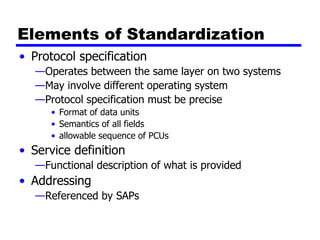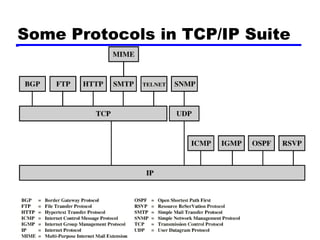cn1.ppt
- 1. Need For Protocol Architecture • E.g. File transfer —Source must activate comms. Path or inform network of destination —Source must check destination is prepared to receive —File transfer application on source must check destination file management system will accept and store file for his user —May need file format translation • Task broken into subtasks • Implemented separately in layers in stack • Functions needed in both systems • Peer layers communicate
- 2. Key Elements of a Protocol • Syntax —Data formats —Signal levels • Semantics —Control information —Error handling • Timing —Speed matching —Sequencing
- 3. Protocol Architecture • Task of communication broken up into modules • For example file transfer could use three modules —File transfer application —Communication service module —Network access module
- 5. A Three Layer Model • Network Access Layer • Transport Layer • Application Layer
- 6. Network Access Layer • Exchange of data between the computer and the network • Sending computer provides address of destination • May invoke levels of service • Dependent on type of network used (LAN, packet switched etc.)
- 7. Transport Layer • Reliable data exchange • Independent of network being used • Independent of application
- 8. Application Layer • Support for different user applications • e.g. e-mail, file transfer
- 10. Addressing Requirements • Two levels of addressing required • Each computer needs unique network address • Each application on a (multi-tasking) computer needs a unique address within the computer —The service access point or SAP —The port on TCP/IP stacks
- 12. Protocol Data Units (PDU) • At each layer, protocols are used to communicate • Control information is added to user data at each layer • Transport layer may fragment user data • Each fragment has a transport header added —Destination SAP —Sequence number —Error detection code • This gives a transport protocol data unit
- 14. Network PDU • Adds network header —network address for destination computer —Facilities requests
- 15. Operation of a Protocol Architecture
- 16. Standardized Protocol Architectures • Required for devices to communicate • Vendors have more marketable products • Customers can insist on standards based equipment • Two standards: —OSI Reference model • Never lived up to early promises —TCP/IP protocol suite • Most widely used • Also: IBM Systems Network Architecture (SNA)
- 17. OSI • Open Systems Interconnection • Developed by the International Organization for Standardization (ISO) • Seven layers • A theoretical system delivered too late! • TCP/IP is the de facto standard
- 18. OSI - The Model • A layer model • Each layer performs a subset of the required communication functions • Each layer relies on the next lower layer to perform more primitive functions • Each layer provides services to the next higher layer • Changes in one layer should not require changes in other layers
- 19. OSI Layers
- 21. OSI as Framework for Standardization
- 23. Elements of Standardization • Protocol specification —Operates between the same layer on two systems —May involve different operating system —Protocol specification must be precise • Format of data units • Semantics of all fields • allowable sequence of PCUs • Service definition —Functional description of what is provided • Addressing —Referenced by SAPs
- 24. Service Primitives and Parameters • Services between adjacent layers expressed in terms of primitives and parameters • Primitives specify function to be performed • Parameters pass data and control info
- 25. Primitive Types REQUEST A primitive issued by a service user to invoke some service and to pass the parameters needed to specify fully the requested service INDICATION A primitive issued by a service provider either to: indicate that a procedure has been invoked by the peer service user on the connection and to provide the associated parameters, or notify the service user of a provider-initiated action RESPONSE A primitive issued by a service user to acknowledge or complete some procedure previously invoked by an indication to that user CONFIRM A primitive issued by a service provider to acknowledge or complete some procedure previously invoked by a request by the service user
- 26. Timing Sequence for Service Primitives
- 27. OSI Layers (1) • Physical —Physical interface between devices • Mechanical • Electrical • Functional • Procedural • Data Link —Means of activating, maintaining and deactivating a reliable link —Error detection and control —Higher layers may assume error free transmission
- 28. OSI Layers (2) • Network — Transport of information — Higher layers do not need to know about underlying technology — Not needed on direct links • Transport — Exchange of data between end systems — Error free — In sequence — No losses — No duplicates — Quality of service
- 29. OSI Layers (3) • Session —Control of dialogues between applications —Dialogue discipline —Grouping —Recovery • Presentation —Data formats and coding —Data compression —Encryption • Application —Means for applications to access OSI environment
- 30. Use of a Relay
- 31. TCP/IP Protocol Architecture • Developed by the US Defense Advanced Research Project Agency (DARPA) for its packet switched network (ARPANET) • Used by the global Internet • No official model but a working one. —Application layer —Host to host or transport layer —Internet layer —Network access layer —Physical layer
- 32. Physical Layer • Physical interface between data transmission device (e.g. computer) and transmission medium or network • Characteristics of transmission medium • Signal levels • Data rates • etc.
- 33. Network Access Layer • Exchange of data between end system and network • Destination address provision • Invoking services like priority
- 34. Internet Layer (IP) • Systems may be attached to different networks • Routing functions across multiple networks • Implemented in end systems and routers
- 35. Transport Layer (TCP) • Reliable delivery of data • Ordering of delivery
- 36. Application Layer • Support for user applications • e.g. http, SMPT
- 37. OSI v TCP/IP
- 38. TCP • Usual transport layer is Transmission Control Protocol — Reliable connection • Connection — Temporary logical association between entities in different systems • TCP PDU — Called TCP segment — Includes source and destination port (c.f. SAP) • Identify respective users (applications) • Connection refers to pair of ports • TCP tracks segments between entities on each connection
- 39. UDP • Alternative to TCP is User Datagram Protocol • Not guaranteed delivery • No preservation of sequence • No protection against duplication • Minimum overhead • Adds port addressing to IP
- 40. TCP/IP Concepts
- 41. Addressing level • Level in architecture at which entity is named • Unique address for each end system (computer) and router • Network level address —IP or internet address (TCP/IP) —Network service access point or NSAP (OSI) • Process within the system —Port number (TCP/IP) —Service access point or SAP (OSI)
- 42. Trace of Simple Operation • Process associated with port 1 in host A sends message to port 2 in host B • Process at A hands down message to TCP to send to port 2 • TCP hands down to IP to send to host B • IP hands down to network layer (e.g. Ethernet) to send to router J • Generates a set of encapsulated PDUs
- 43. PDUs in TCP/IP
- 44. Example Header Information • Destination port • Sequence number • Checksum
- 45. Some Protocols in TCP/IP Suite












































